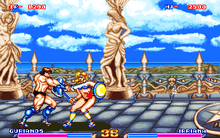Blandia
| Blandia | |
|---|---|
|
Front side of European arcade flyer of Blandia. | |
| Developer(s) |
Allumer (arcade) Ving (ports) |
| Publisher(s) |
Allumer (arcade) Ving (ports) |
| Designer(s) | Ken Kaneda and team[1] |
| Platform(s) | Arcade Game, FM Towns, NEC PC-9801 |
| Release date(s) |
Arcade 1992 FM Towns September 30, 1994 NEC PC-9801 June 22, 1995 |
| Genre(s) | Fighting game |
| Mode(s) | Single player, 2-player |
| Cabinet | Horizontal |
| CPU | 68000 |
| Sound | Seta X1-010 |
| Display | Raster, 384 x 240 pixels, 1536 colors |
Blandia (ブランディア Burandia) is a 1992 one-on-one, weapon-based fighting arcade game developed and published by Allumer. It is the sequel to the 1986 arcade game, Gladiator. Along with Strata's Time Killers, Blandia is one of the earliest weapon-based fighting games modeled after its competitor Capcom's 1991 arcade hit Street Fighter II, but later became overshadowed by the success of SNK's 1993 weapon-based fighting game, Samurai Shodown.
Plot
The plot of Blandia takes place five years after Gladiator. In the Great Continent of Eurasia, after the great swordsman Gurianos downed the devilish warrior Gildus, peace returned to Eurasia and its people completely forgotten the darkness sealed by the evil spirit. Five years later, while living in the interior of Eurasia, Guarianos learns from a passing fencer that Gildus has been resurrected. Gurianos once again hits the road to the Golden Castle (黄金の城 "Ougon no Jō" (sometimes "Ougon no Shiro")) to find out the truth.[2]
Gameplay
Blandia dismisses the side-scrolling feature of its predecessor, but kept its versus segments while including elements of other 2D versus fighting games released at the time, which the player's chosen character fights against his or her opponent in best two-out-of-three matches in a single player tournament mode with the computer or against another human player. Unlike most other similar fighting games at the time, Blandia was one of the first fighting games that combines the style of Capcom's Street Fighter II with the use of weapons in every character. Another unique feature it has is the ability to cause visible damage to the armors of the characters, originally used in Gladiator. However, unlike Gladiator, Blandia requires players to attack at the uncovered parts of the opponent's body multiple times to defeat him or her, instead of one hit like in Gladiator.
In one-player mode, the player must choose one of the "Original Six Warriors" to control. Instead of fighting other characters in a random order like in most fighting games back then, the player will move the sword-shaped cursor on a map to choose any region one of the other characters are inside of, fight against them in each battle and then advance to the Golden Castle. In both one-player and two-player modes, each round is five minutes long, and if neither of the characters are knocked out before the time runs out, the one with the most health wins the round; however, if both lifebars are even, the players must fight in a rematch. If both lifebars are even in the rematch, the fight ends with a game over.[2]
Characters

- Gurianos (ガリアノス) - The protagonist of the game. He loves justice and is the man of righteousness. Designed for beginners, he is an average fighter with no weak points, and is armed with a double-edged sword and a shield. His sorcery is light-based.[2] He was originally the player's character in Gladiator and his name back then was spelled Guaranos.
- Diokles - A nihilistic fighter who is considered the rival of the main character Gurianos and as such they both share similar move sets (albeit using different names). Diokles has better agility and hitting power than Guarianos. His sorcery is fire-based.[2]
- Irriana - A temperamental female warrior who eats when she wishes, and fights only when she desires to. She is armed with a short sword, a round shield. While her sorcery is explosive-based, she mainly uses its related tricks. She is also relatively agile and has an intense jumping ability.[2] Like Gurianos, Irriana is another character returning from Gladiator, and her name back then was spelled Irene.
- McGill - A male warrior full of confidence. He cuts by power with a longsword and uses large tricks with a hig. His body stamina and power, compared to his longsword, are far superior. He has no sorcery.[2]
- Jurane - An elegant, but harsh female fighter. She has the longest reach, but the least power, due to her weapon of choice being a short lance. Her sorcery utilizes various powerful magic tricks.[2]
- Retsu.Zen - A man who is brave enough to take a defiant attitude toward his enemies and critical situations. He is the quickest fencer, has repetitively strong offense and is armed with two-swords. Lack of either speed or offense wouldn't be enough for him. His sorcery is referred to as "Zen Oriental Magic".[2]
Non-playable Characters
- Launa
- Xeldus
- Imageo
- Gildus
Ports
Blandia was later ported by Ving to two home computers exclusively in Japan: the FM Towns on September 30, 1994, and the NEC PC-9821 on June 22, 1995. Compared to the original arcade version, the FM Towns version features an extended, less-repetitive soundtrack plus some exclusive tracks that includes a vocal one, but it also has a smaller screen. The PC-9821 version was titled Blandia 98 and has a wider screen than the FM Towns version.
References
External links
- Blandia at The Large Cult Fighting Game March (Japanese)
- Blandia at Hardcore Gaming 101
- Blandia at the Killer List of Videogames
- Blandia at arcade-history
